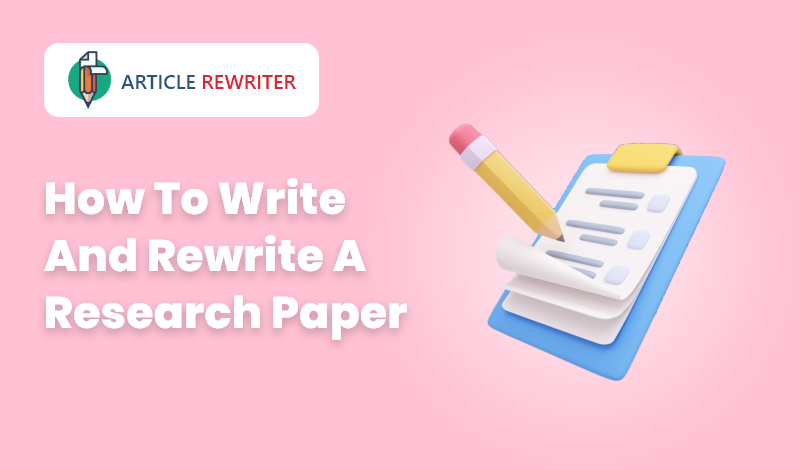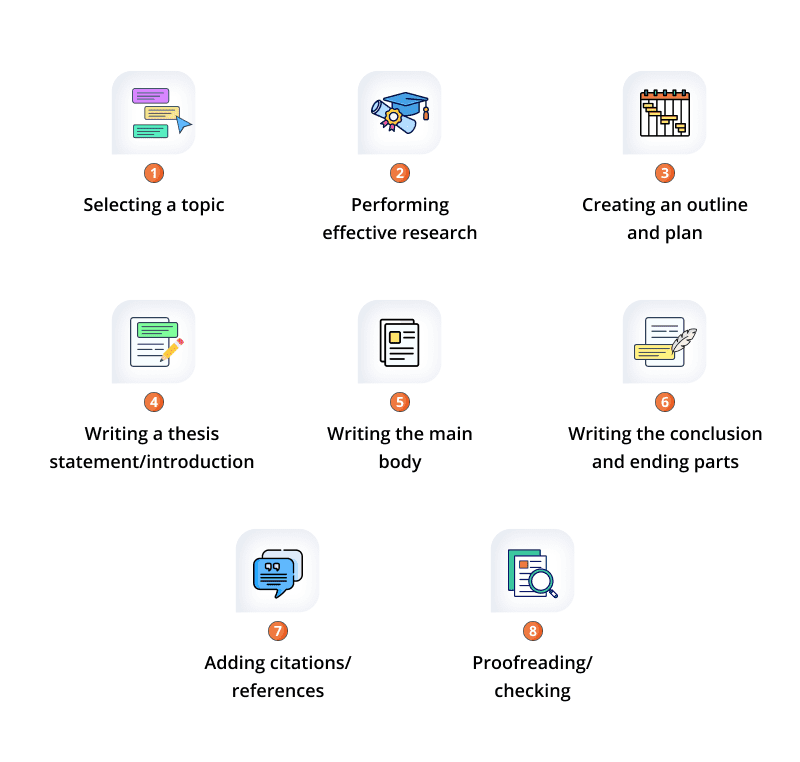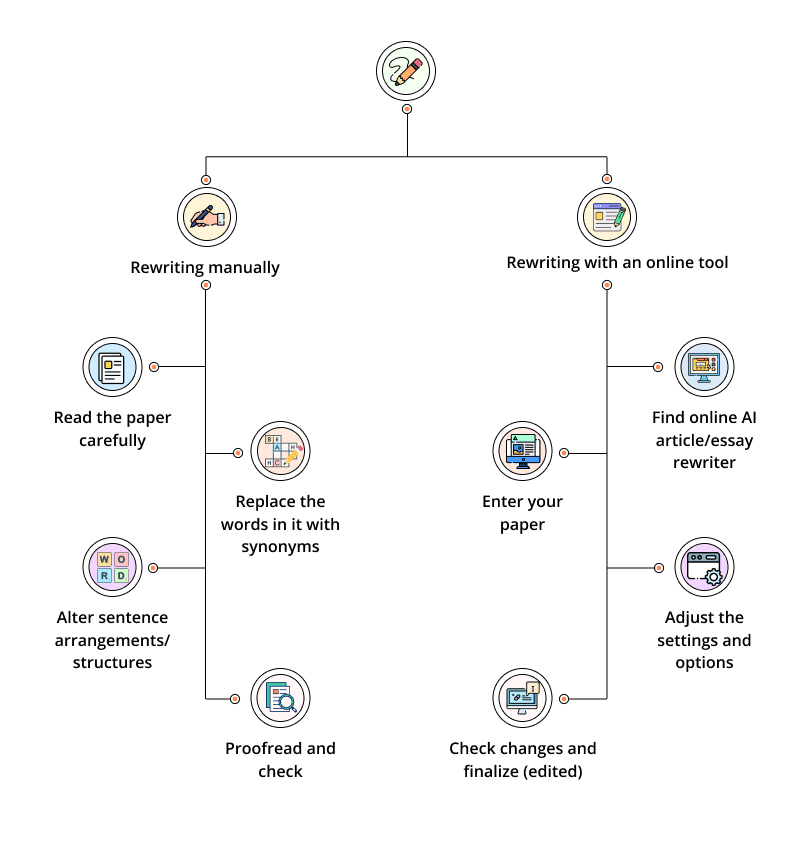
How to Write and Rewrite a Research Paper
A research paper is a piece of academic content that is written to explain and elaborate on a research study and its findings. There are many different rules and regulations that govern the way these are written. For example, the tone with which they are written and the method in which the arguments and research are presented, etc., all have to conform to a specific style.

Along with all of this, research papers have to be written in an authoritative way so that they are perceived as credible. It is for this reason that writing them can be difficult and tricky.
But don’t worry. In this guide, we are going to tell you all about writing excellent research papers. And when we are done with that, we will also talk about how you can rewrite a research paper. We will include that in a separate section, and we will also explain why rewriting research papers can be required in the first place.
A Full Guide to Write a Research Paper

Here is how you can write a high-quality and authoritative research paper. Here are the steps that make up the process:
- Selecting a topic for the research paper
- Performing effective and authoritative research
- Creating an outline and plan for the paper
- Writing a thesis statement/introduction
- Writing the main body
- Writing the conclusion and ending parts
- Adding citations and references
- Proofreading and checking
1. Step 1: Select a Topic for the Research Paper

You have to choose a topic for your research paper if you have not been provided with one by your teacher or institute, etc. There are many considerations that you have to keep in mind when choosing a research topic.
Here are some of them:
- You should pick a topic that you yourself are knowledgeable about or are interested in. If you are already familiar with it, you will be able to write with a better base. And if it is something that is interesting to you, you will be able to write properly and thoroughly without considering it a burden.
- You should pick a topic that complies with the guidelines and instructions that you have been provided. Depending on which institute you belong to, there may (or may not) be a host of different guidelines and criteria that the topic should conform to.
- Another factor to consider when choosing a topic is how useful it is. There may be something that you may have knowledge about, or you may be interested in, but it could have very limited utility or value. It may be something short-lived that may cease to exist or be of importance in a matter of months or years. You need to make sure that you pick something timeless and helpful.
2. Step 2: Performing Effective and Authoritative Research

The next step that follows in writing a research paper is research.
Research is necessary for every type of writing, but it becomes vital when it comes to writing research papers. The very purpose of research papers is to expound and explain research – which is only possible when the latter is done and done properly.
When performing research for your paper, you have to ensure that it is done from credible sources. If the sources are credible, the information taken from them is likewise credible, and the same quality is inherited by the paper itself.
To make your research effective and authoritative, here are some tips that you should follow:
- Pick research material from well-known academic sources. They include sources such as:
- Google Scholar
- JSTOR
- ResearchGate
- Library of Congress
- If there are any guidelines or instructions provided to you regarding the sources to pick, make sure to adhere to those.
- Perform your research from multiple different sources instead of using one or two. This helps you get a panoramic perspective of the content that you have to write, and you are less prone to accidentally copy something verbatim.
- When doing your research, save the details of the sources where you take information so that you can create citations and references later on
3. Step 3: Creating an outline or plan for the paper

The next thing that you have to do in the process is create an outline or plan for the paper. There are many benefits in planning the paper out before writing it.
For one, it helps you define your writing route so that you don’t start on something you’re not supposed to. It also helps you avoid the hassle of thinking about what to write as you go along. Once the outline is made, you can start writing in a flow without deliberating about what to include.
Here are some points to keep in mind when it comes to creating an outline for the paper:
- Describe the different headings that you want to include in your paper. Be sure to include aspects that are neither too broad to be unhelpful nor too specific to be peripherally useless save for their exact application.
- You should also highlight the sub-headings to be included in each heading. This can further help you stay on track about what to discuss in each part.
- Demarcate a word count for each part. This becomes necessary if the paper you’re writing has a strict word limit imposed on it. Should this be the situation, you can write the name of each of the headings and then the expected word count in front of it. Then, when the time comes to actually write the paper, you can simply follow those counts and avoid making anything needlessly lengthy.
4. Step 4: Writing a Thesis Statement/Introduction

The thesis statement and the introduction are more or less the same thing. They are the starting parts of the paper that describe its topic and purpose. If the paper is an explanatory one, then the thesis statement briefly describes the entire explanation, which is then elaborated in the paper itself. On the other hand, if the paper is in response to a particular
There is a specific way in which you have to write the thesis statement. We will now discuss some of the main tips and steps that you have to follow when writing one:
- The thesis statement has to be strictly on point. While the other parts of the paper can go into peripheral details that aid the explanation (while not being strictly relevant to it), the same cannot be done with the research paper.
- The thesis statement has to sum up the crux of the paper. It has to include the things that the paper includes. The statement has to be written in such a way that the entire paper’s contents can be easily gauged by it.
- The statement should also include the conclusive findings of the paper. Depending on what kind of paper you are writing, these findings can be different. They should be included in the thesis statement as well.
5. Step 5: Write the Main Body

After that comes the main step, i.e., writing the main body of the research paper.
Normally, the main body of the research paper is divided into the following sections:
- Literature review
- Methods
- Results and findings
- Explanation and discussion
Depending on the type of paper that you’re writing, all of these sections may not be included. It is also possible that your institute may have provided you with specific sections to include in the paper.
Regardless of the sections, there are a few things that you have to keep in mind about writing them. This part of our point mostly deals with those.
- Tone and Style: When writing the main body (or any other part of the paper, for that matter), one of the main things that you have to be careful about is the tone and style. Your tone has to be strictly formal and academic. This can be done by avoiding slang, colloquialisms, and casual forms of speech.
- Readability: Another aspect to be mindful of in the research paper is readability. You have to take care to keep the writing of your paper readable and easy to understand. While technical details and explanations are unavoidable, you have to maintain readability in everything else. You have to use easy wording and simple sentences for everything that you write.
- Organization and Formatting: The way you organize and format your research paper has a significant effect on its quality. There are different elements included in the organization and formatting of the paper, for example:
- The length of the paragraphs and the sentences. When your research paper is made up of short paragraphs and sentences, it is much easier to go through and understand. Your paragraphs should be 3 to 5 lines long at most, while your sentences should be capped at 20 words.
- The arrangement of the subheadings in each of the parts. While the major breakdown of a research paper includes the method, literature review, etc., you also have to make further sub-headings in each part. This is to organize the content and to separate all the arguments/explanations from one another.
6. Step 6: Writing the conclusion/ending parts

Like the thesis statement/introduction, the conclusion and editing parts of the research paper have to be written concisely. The conclusion has to be such that it conveys the entire purpose and point of the research paper without taking up a lot of page space.
To write a good conclusion, you can do the following:
- Provide a brief summary of the research topic as well as the purpose of the paper
- Reiterate the main headings and points that you’ve added to the paper
- Reiterate the final findings or conclusions that you’ve drawn in the research paper
7. Step 7: Adding citations and references

Conventionally, citations and references are added to the paper as it is being written. However, for the sake of maintaining a flow, it can be better to leave a mark or indication at the points of citations at the time of writing and then put them in full once you’re done.
During your research, you should make a careful note of all the sources that you take information from. Then, you should cite the source at the point in the content where that particular information is used.
There is a difference between citations and references.
- Citations are the small pieces of text that are inserted in between the text to indicate a source. They are put in between two parentheses, and they usually mention the name of the researcher along with the publishing date of the source (Example, 2023).
- References, on the other hand, are the details of the sources from where the information is taken. They contain the date of publishing of the source along with the name of the authors/researchers, the exact URL, or the DOI number.
8. Step 8: Check and Proofread

This is the last step in the research paper writing process.
After you have written everything and added the references, etc., you should proofread the content from start to finish. The purpose of proofreading is to check for different types of errors and imperfections in the paper. These errors include things like:
- Grammar mistakes
- Spelling and punctuation mistakes
- Improper organization
- Missing citations and references
- Incorrect citations and references
- Improper formatting
To proofread your text, you just have to go through it a couple of times slowly and carefully. Another good idea to effectively proofread a paper is to do it after a few days. If you have the time, you should write it and then leave it for a couple of days. After that, when you read the content, you will be more critical and aware of the errors.
A Guide to Rewrite a Research Paper
Now that we have looked at the process of writing a research paper, let’s move on to the rewriting guide.
Rewriting is a different process than writing. While writing means creating the paper from scratch, rewriting means changing an existing one to alter the way it looks and reads.
There are many different reasons for rewriting an academic paper. In the following parts of this post, we are going to look at all of that.
What is the need to rewrite a research paper?
The need to rewrite a research paper can be due to different reasons. Here are some of the main ones:
- Improving the quality: One of the reasons that anyone may want to rewrite their research paper is to improve its quality. When writing for the first time, there could be issues in it, like clunky sentences or weird word usage, etc. After you’re done, you may want to rewrite the text for better quality.
- Reusing the paper in a different place: Another reason for rewriting text is if you ever need to reuse it in a different time or place. For example, if you wrote a research paper and then some months later, you are assigned the same topic again or something very similar, you can rewrite the existing content to make it different and unique before using it again. This is something you can do if the teacher allows it. By rewriting the paper, you can put enough effort to make it count.
- To get rid of accidental plagiarism: Accidental plagiarism is a problem that troubles academic writers and students in almost all of their writing endeavors. It occurs when the written content matches with some material already existing on the Internet. By rewriting the paper (the specific affected parts), you can make it unique and original again.
How is rewriting done?

Rewriting can be done in two different ways. It can be done manually, or it can be done with the help of an online tool. We will now discuss both of the processes one by one.
Rewriting manually
1. Read the paper carefully
The first step in manual rewriting is to read the research paper carefully from the beginning to the end.
One thing to remember about rewriting is that the meaning has to remain the same.
In other words, when a piece of text is rewritten, it is important for the meaning and the context to remain unchanged.
This also applies to rewriting a research paper. If you want to make the process thorough and accurate, you should thoroughly read the content and familiarize yourself with all the information that it contains. You should note all the main points down so that you can later tally them off with the rewritten version.
2. Replace the words in it with synonyms
After that follows the synonymizing part.
To rewrite a research paper, one of the common changes that you can make to it is replacing the words it contains with their synonyms. In other words, you can swap the words out and replace them with alternatives to make the write-up look different.
For example, if the content contains some text that goes:
The study related to the mutation led to the belief that it was not genetic, as was believed in the past. Rather, it was a disease that developed in a rare proportion of the population.
…it could be reworded as:
The research related to the mutation led to the notion that it was not hereditary, as was the belief in the past. Rather, it was a sickness that developed in a select part of the population.
3. Alter the sentence arrangements and structures
After rewording, another change that you have to make is changing the sentence structure and arrangement. This basically refers to changing the positioning of the components such as subject, object, verb, etc. In a complex sentence, it can also mean changing the placing of the two closes – which would lead to a change from active voice to passive and vice versa.
Here is an example:
The study related to the mutation led to the belief that it was not genetic as was believed in the past. Rather, it was a disease that developed in a rare proportion of the population.
…here is the altered version:
Contrary to what was believed in the past, the study related to the mutation revealed that it was not genetic. Developing in a rare proportion of the population, it was a disease.
4. Proofread and check
Once all the changes are made to the text, the final step is to review and proofread it. You have to proofread the rewritten text to ensure that it does not contain any contextual issues. In other words, you have to ensure that the changes you’ve made to the text have not led to any change in the meaning and context of the text.
Rewriting with an online tool
The process includes the steps that you have to follow to rewrite a research paper manually. Now, we will discuss the steps for doing the same thing with an online tool.
1. Find an online AI article or essay rewriter
When you want to rewrite something with an online tool, the first thing you need to do is find one.
Online article rewriters exist in abundance on the Internet. However, to make sure you get the most out of them, you have to be picky and selective.
Here are some things that you should keep an eye out for when finding an online AI article rewriter:
- The popularity of the tool.
- The working and accuracy of the tool.
- The availability of the tool.
- The features and options provided by the tool.
If a tool is good, it will likewise be popular. That is why the popularity is a good indication of the quality of a tool. As for the other factors, it is easy to understand why they are necessary to be checked.
2. Feed your paper to the online tool
The next step is fairly simple and straightforward. You have to enter the text of your research paper into the tool so that the process can begin.
However, there is one thing that has to be kept in mind here. Most online AI rewriters come with a specific word limit – that goes from around 500 words to 1,000.
A research paper is typically written above this number of words. You will have to split it up and rewrite it piece by piece…if the tool you’re using comes with a word limit.
3. Adjust the settings
After the text has been entered, the next thing on the checklist is to adjust the settings and options of the tool. The “settings” that we refer to here can vary from tool to tool.
In some rewriting tools, there are multiple writing tones or “modes” that you can pick from. In others, there is an option that allows you to stop certain words from being rewritten, etc.
Depending on the tool that you’ve picked, you have to adjust the settings as per your needs and requirements. After that, you can start the process.
4. Check the changes and finalize
Once the rewriting is done, you have to do the same thing as in manual rewriting: checking and proofreading.
When you’re using a tool, this part becomes more important because you are not aware of the changes that have been made to the text. You have to check each and every one of them to see if they are aligned with the original meaning or not. Tools can sometimes make strange changes to the text that can alter its meaning/context. You have to ensure that does not happen with your research paper.
Conclusion and Final Thoughts
And that wraps it up.
Writing and rewriting a research paper are two different processes. Writing a paper means penning it up from scratch. There are different steps that it involves, such as selecting the right topic, performing proper research, and so on.
On the other hand, rewriting a paper means to restate an existing one. It can be done manually or with the help of an online tool.
In the post above, we’ve talked about all of these processes in detail.



